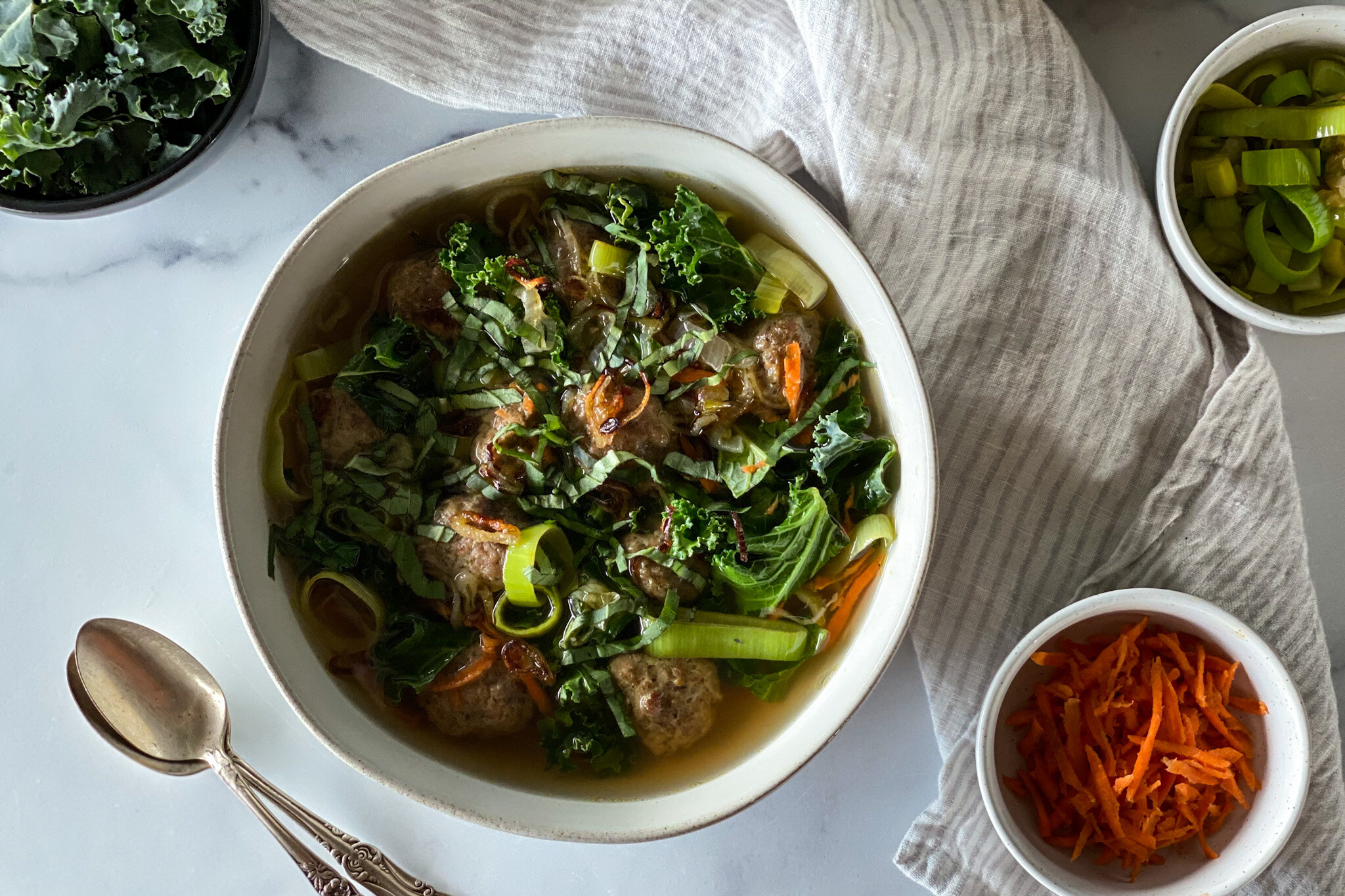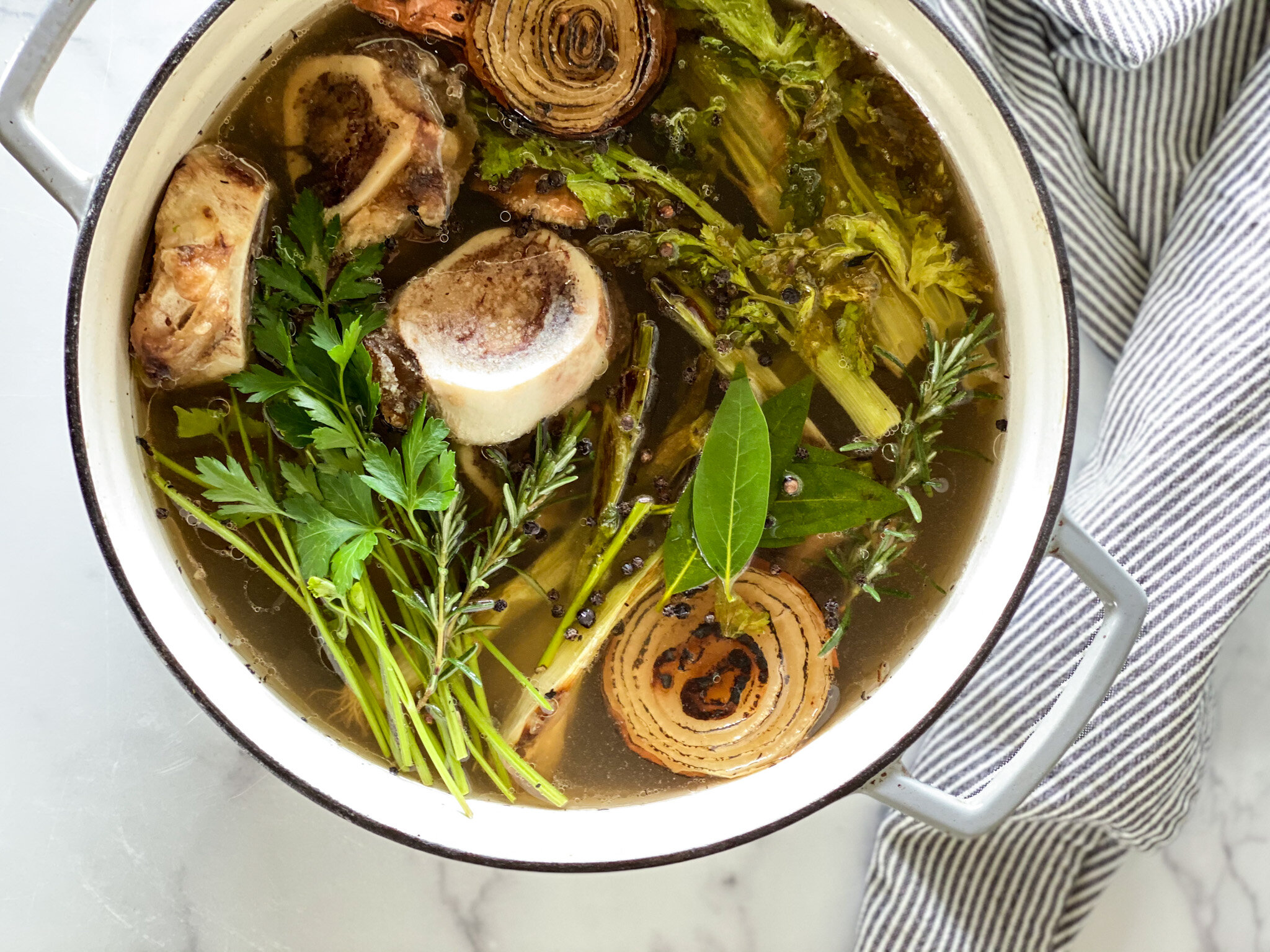How to: Five-Minute Breakfast Soup
/Breakfast soup may seem like an unconventional choice, but this tutorial for Five-Minute Breakfast Soup will turn you into a breakfast-soup-believer! You can throw together a satisfying, deeply nourishing soup packed with greens, veggies, potatoes, meat, or eggs and adapted to fit any flavor profile in just five minutes. Jump to tutorial.
Friends, let me tell you something…breakfast soup is the new green smoothie. I know the concept may sound odd, but hear me out: breakfast soup can be just about anything you want it to be – packed with greens, roasted veggies, potatoes, fresh herbs, noodles, meat, or eggs and adapted to fit any flavor profile.
Soup may not be a typical breakfast in the states, but all over the world different soups + stews are commonplace at the breakfast table. Whether it’s changua in Colombia, menudo in Mexico, miso in Japan, congee in China, or Mohinga, a common pho-like street food eaten for breakfast in Myanmar, other cultures know that soup delivers essential nutrients and can be make a wonderfully nourishing breakfast.
Soup is known to support digestion and boost energy levels, all while boosting your veggie & nutrient intake for the day. It’s like the cold weather version of a green smoothie and I am here for it.
You may be thinking that having soup for breakfast may seem like a great idea in fall + winter, but you can also have soup for breakfast in the summer; if you don’t feel like hot soup in the summer months, you can try refreshing chilled soup recipes like gazpacho.
What we’re not doing: making a big batch of one kind of soup and eating that throughout the week. Instead, we’re keeping things simple + exciting by making a single serving of breakfast soup from pre-prepped or leftover ingredients we already have on hand in about 5-10 minutes.
The base of a quick + easy breakfast soup is good quality broth or stock. Then I like to incorporate tons of aromatics, greens and pre-cooked vegetables with leftover meat or a soft-boiled egg. The best part? You can mix and match whatever your favorites are – there are no rules.
Aromatics such as ginger, garlic, and turmeric provide flavor + nutrients, umami ingredients like tamari, miso, or fish sauce provide an instant flavor bomb, and pre-cooked or quick cooking greens, veggies, meat or eggs provide nourishment + calories and fresh herbs, bean sprouts, or a squeeze of citrus add brightness.
STEP-BY-STEP HOW TO: FIVE-MINUTE BREAKFAST SOUP
STEP 1: AROMATICS
In a small saucepan, start by sautéing 1-2 tablespoons aromatics like fresh, minced garlic, ginger, turmeric, peppers, onion, leeks or shallots in little olive oil until soft + fragrant. Aromatics will deliver deep, rounded flavor + aroma to your breakfast soup when you sweat them a bit before adding the broth.
STEP 2: BROTH BASE
Next, poor in about 2 cups of the broth of your choice. The base of a quick + easy breakfast soup is good quality broth or stock. You can make your own or buy a high-quality broth from your local or online grocery store [I like Bonafide Provisions, Thrive Market, or Nona Lima broths]. The sky is the limit here — you can use chicken, beef, lamb, turkey, pork, bison, mushroom or vegetable broth as your base.
STEP 3: MIX-INS
Add umami to your soup with mix-ins like tamari, chickpea miso, or fish sauce provide depth and an instant flavor bomb. You can also add sambal chili paste, tomato paste, harissa, pesto, salsa verde, or ghee, butter, or coconut milk for a creamier soup. If your broth is on the richer side, add a splash of vinegar, lemon or lime juice to bring some brightness + balance.
STEP 4: PROTEIN
Add 4-5 ounces of pre-cooked protein or 1-2 soft boiled eggs. I usually opt for leftover shredded beef or chicken and/or a soft-boiled egg in my breakfast soup but you can do any variation of pre-cooked shredded or ground chicken, beef, lamb, turkey, pork, bison, or even bacon, sausage, or eggs for the ultimate breakfast vibe.
You can also poach an egg or two in the broth before adding additional ingredients. Simply bring the broth to a simmer. The broth should be between 190-195 degrees F since the eggs will bring the water temp down to the optimal spot. Create a vortex of broth with a spoon, crack the egg over a fine mesh sieve placed over a small bowl and gently slide it into the middle of the vortex directly from the sieve. Set a timer for 3 minutes, remove the egg from the broth using a slotted spoon, and set aside until the rest of your breakfast soup is prepared. Before serving, add poached egg and the soup will rewarm the egg. If you’re new to poached eggs, make sure to read through my how-to here.
STEP 5: GREENS + VEG + LEGUMES
Add 1-2 cups of greens, quick-cooking/leftover veggies or legumes for filling nutrients, flavor, and texture. This is great opportunity to use up those random greens leftover in your fridge! I typically use pre-chopped or shredded kale or cabbage for a quick add-in. You can opt for spinach, collards, chard, arugula or mustard greens. I also love adding colorful veggies like sautéed peppers, mushrooms, cabbage or roasted bok choy, carrots, cauliflower, broccoli, potatoes, beets or tomatoes. Pre-cooked or canned lentils, chickpeas, cannellini beans or other legumes are also a wonderful addition to breakfast soup.
STEP 6: TOPPINGS
Get crazy with your garnish, paying special attention to flavor + texture! I love to add extra fat + crunch in this last step.
Add more greens: broccoli sprouts, alfalfa sprouts, pea shoots, micro-greens, scallions, and fresh herbs like cilantro, basil, tarragon, parsley or mint add a great nutritional punch and a ton of fresh flavor + texture.
Add extra fat + texture: olive oil, sesame oil, avocado, crumbled feta or cotija cheese, fresh grated parmesan, yogurt or sour cream add a boost of healthy fat and a creamier texture. For a little crunch + fiber, add some pine nuts, sunflower or pumpkin seeds. Want next level crunch + flavor? Add homemade croutons, crispy prosciutto or bacon, parmesan crisps, tortilla chips, fresh sauerkraut or pickled veggies.
Season it up: top with flavored or smoked salt, tajin, gomasio, or furikake to add a nice finishing flavor
SOME OF MY FAVORITE COMBINATIONS
ITALIAN MEATBALL SOUP: shallot or garlic, leeks, beef broth, leftover meatballs, lemon juice, shredded kale, grated carrots
BROTHY ROASTED TOMATO + AVOCADO SOUP: shallot or onion, jalapeño, chicken broth, salsa verde, roasted grape tomatoes, avocado, soft-boiled or poached egg, fresh cilantro, dill, and scallions
EGG & MISO BREAKFAST SOUP: ginger, pork broth, chickpea miso, shiitake and beech mushrooms, spinach, soft-boiled or poached egg, scallions
how to: five-minute breakfast soup
Breakfast soup may seem like an unconventional choice, but this tutorial for Five-Minute Breakfast Soup will turn you into a breakfast-soup-believer! You can throw together a satisfying, deeply nourishing soup packed with greens, veggies, potatoes, meat, or eggs and adapted to fit any flavor profile in just five minutes.
STEP 1: AROMATICS
In a small saucepan, start by sautéing 1-2 tablespoons of aromatics like fresh, minced garlic, ginger, turmeric, peppers, onion, leeks or shallots in little olive oil until soft + fragrant. Aromatics will deliver deep, rounded flavor + aroma to your breakfast soup when you sweat them a bit before adding the broth.
STEP 2: BROTH BASE
Next, poor in about 2 cups of the broth of your choice. The base of a quick + easy breakfast soup is good quality broth or stock. You can make your own or buy a high-quality broth from your local or online grocery store [I like Bonafide Provisions, Thrive Market, or Nona Lima broths]. The sky is the limit here — you can use chicken, beef, lamb, turkey, pork, bison, mushroom or vegetable broth as your base.
STEP 3: MIX-INS
Add umami to your soup with mix-ins like tamari, chickpea miso, or fish sauce provide depth and an instant flavor bomb. You can also add sambal chili paste, tomato paste, harissa, pesto, salsa verde, or ghee, butter, or coconut milk for a creamier soup. If your broth is on the richer side, add a splash of vinegar, lemon or lime juice to bring some brightness + balance.
STEP 4: PROTEIN
Add 4-5 ounces of pre-cooked protein or 1-2 soft boiled eggs. I usually opt for leftover shredded beef or chicken and/or a soft-boiled egg in my breakfast soup but you can do any variation of pre-cooked shredded or ground chicken, beef, lamb, turkey, pork, bison, or even bacon, sausage, or eggs for the ultimate breakfast vibe.
You can also poach an egg or two in the broth before adding additional ingredients. Simply bring the broth to a simmer. The broth should be between 190-195 degrees F since the eggs will bring the water temp down to the optimal spot. Create a vortex of broth with a spoon, crack the egg over a fine mesh sieve placed over a small bowl and gently slide it into the middle of the vortex directly from the sieve. Set a timer for 3 minutes, remove the egg from the broth using a slotted spoon, and set aside until the rest of your breakfast soup is prepared. Before serving, add poached egg and the soup will rewarm the egg. If you’re new to poached eggs, make sure to read through my how-to here.
STEP 5: GREENS + VEG + LEGUMES
Add 1-2 cups of greens, quick-cooking/leftover veggies or legumes for filling nutrients, flavor, and texture. This is great opportunity to use up those random greens leftover in your fridge! I typically use pre-chopped or shredded kale or cabbage for a quick add-in. You can opt for spinach, collards, chard, arugula or mustard greens. I also love adding colorful veggies like sautéed peppers, mushrooms, cabbage or roasted bok choy, carrots, cauliflower, broccoli, potatoes, beets or tomatoes. Pre-cooked or canned lentils, chickpeas, cannellini beans or other legumes are also a wonderful addition to breakfast soup.
STEP 6: TOPPINGS
Get crazy with your garnish, paying special attention to flavor + texture! I love to add extra fat + crunch in this last step.
Add more greens: broccoli sprouts, alfalfa sprouts, pea shoots, micro-greens, scallions, and fresh herbs like cilantro, basil, tarragon, parsley or mint add a great nutritional punch and a ton of fresh flavor + texture.
Add extra fat + texture: olive oil, sesame oil, avocado, crumbled feta or cotija cheese, fresh grated parmesan, yogurt or sour cream add a boost of healthy fat and a creamier texture. For a little crunch + fiber, add some pine nuts, sunflower or pumpkin seeds. Want next level crunch + flavor? Add homemade croutons, crispy prosciutto or bacon, parmesan crisps, tortilla chips, fresh sauerkraut or pickled veggies.
Season it up: top with flavored or smoked salt, tajin, gomasio, or furikake to add a nice finishing flavor
Don't forget to tag us @thenorthwestkitchen on Instagram when you use this tutorial to dream up a delicious breakfast soup!


































